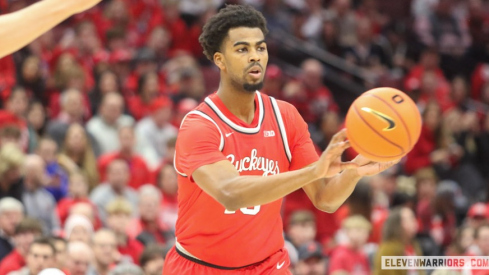Former North Carolina defensive end Beau Atkinson commits to Ohio State.

The Ohio State defensive coaching staff made a strategic choice against Wisconsin's talented rushing attack. The Buckeyes would scheme to take away the Badgers' downhill run game and jet sweep series, daring Wisconsin to throw the football.
To implement this plan Luke Fickell and Everett Withers relied upon their talented cornerback Bradley Roby to fulfill two roles. Roby would both shadow Wisconsin's top wide receiver Jared Abbrederis across the field and provide contain support against the jet sweep.
The Buckeyes' strategy succeeded, holding the Badgers to 104 yards. But Wisconsin threw the football more successfully then the Buckeyes' coaching staff could have imagined, keeping the Badgers within striking distance.. Despite this the Ohio State coaching staff stuck to their game plan. Urban Meyer and his staff wanted to force Wisconsin to operate outside their comfort zone to beat Ohio State, a decision that was ultimately proven to be the correct one.
Below I address the Buckeyes' approach, Roby's role and play, the bigger problem with Ohio State's pass coverage, and tipping your hat to the competition.
Playing the Field
Against Wisconsin's 21 personnel (2 RB, 2 WR, 1 TE), Ohio State generally aligned their defensive front in an over or under to the field. That meant the Buckeyes placed their formation strength to the wide side even if Wisconsin aligned their formation strength to the boundary.

The Buckeyes' boundary corner would play force support outside the tight end to compensate.
Roby is normally the boundary corner with Doran Grant playing to the field. But the Buckeye coaching staff altered that formula Saturday. Roby followed Abbrederis to whatever side the wide receiver aligned. If Abbrederis went to the wide side so did Roby and vice versa.
The Buckeyes put Roby on Abbrederis to often play aggressive cover 1 to support the run, generally bringing one of their safeties in the box. The strategy was a success. The Badgers had some positive plays running to the boundary but the Buckeyes prevented any run plays over 20 yards and held Wisconsin to a far lower rushing output then their average by any statistical measure.
The Buckeyes defensive line, particularly Michael Bennett, controlled the line of scrimmage and got penetration into the backfield. Ryan Shazier cleaned up from there. Shazier put on a textbook performance playing the run. He scraped from the inside-out, played across blocks, and used his speed to quickly close holes. Shazier has taken huge strides in the technical aspects of the linebacker position.

On third down the Buckeyes utilized an 30 front dime formation. The Buckeyes employed three defensive linemen with Josh Perry joining Shazier as the two linebackers.This provided Ohio State the flexibility to bring blitz schemes or drop into eight man zone coverage.

You Know its Coming...
All week leading up to the game Meyer repeatedly expressed his concern with Wisconsin's jet sweep. Threatening a defense's edge when it is concerned with the inside run game, the Badgers' jet sweep has been effective for years. But it is perhaps even more dangerous this season with Melvin Gordon.
The Buckeyes made preventing Gordon from gaining the edge their next priority. To do so the Buckeyes had Roby quickly fill in contain. By following Abbrederis, Roby would line up opposite Gordon when he was placed in the flanker spot. This allowed Roby to provide run support against the play, at which he is so effective.
Piling On
In addition to this duty Roby was asked to play Abbrederis in man coverage across the field, often with little help. Much has been made of Roby's performance (or lack thereof) and there is no denying that Abbrederis bested Roby on several occasions. Roby is a physical corner who is perhaps better suited for playing to the boundary then playing man across the field.
But putting this aside, Roby's performance must be put into context. Playing man coverage all over the field is difficult, which is why defenses are often wary to do so. It is made more difficult when a cornerback is given sizeable run responsibilities.
The degree of difficulty is even greater when, as a corner, you have to defend deep routes with a receiver who has time to make multiple moves because of a lack of pass rush. For instance, on Wisconsin's first touchdown pass, the Buckeyes brought a six-man pressure that failed to get to Joel Stave. With time Stave was able to deliver a perfect throw.

Like most quarterbacks, Stave was far more successful when he had a pocket than when he had to throw under pressure.
But the lack of pass rush was at times a result of the Buckeyes' run-first focus. Below the Buckeyes' defensive front primary focus is the run fake, providing Abbrederis time to run an out and up.
In some ways then, Roby was set up for failure. He was asked to eliminate Abbrederis while the other ten defenders stopped the run.
Underneath System Failure
Although the focus was upon Roby's performance, much of Abbrederis' success came in exploiting Ohio State's zone coverage. Abbrederis' longest catch was a result of a coverage breakdown. Wisconsin ran a Mills route, meaning that, from the slot, Abbrederis runs a curl route with the outside receiver running a post. It is unclear whether Ohio State was playing quarter-quarter-half or cover 2. If it was the former Roby blew the coverage, because he played the flat as if it was cover 2.
If Roby was at fault it shows the limitations of changing your formula for one game. For years Roby has played boundary corner. In quarter quarter half coverage to the boundary he would play cover 2. He now must fill a separate responsibility to the field. That is not to excuse a missed assignment, but making game to game adjustment such as this will inevitably lead to mental breakdowns.
If it was the latter, Josh Perry failed in performing his hook to curl coverage. As the number two outside defender Perry is responsible for the vertical hook zone. As Brophy writes
The weak side linebacker who responds to the displaced #2 receiver should be playing a "vertical hook technique". This simply means he is controlling the vertical stem of #2 into the hook zone and will treat this area as a priority. He should be thinking vertical-in-the-seam by #2 on pass key, and defend this throw first. On pass, he must relate to #2 receiver. He will peek to #1 receiver to identify the route concept he should play.
In other words, the linebacker better defend the hook area by getting the proper depth and re-routing the wide receiver. But on the play below, Perry failed to re-route Abbredaris, did not get proper depth and then chased a flat route.
In either event Roby and Abbrederis ended up next to each other, allowing Abbrederis to run a hook into a wide-open area.

Grant compounded the problem. He follows the run action, which is acceptable. But once he recognizes it is not a run he needs to run as hard as he can to his drop zone. He instead gets stuck in no-man's land. Grant and Perry have at times struggled in re-routing receivers and getting proper zone depth.
An offense making plays by exploiting what the defense is conceding is easier to swallow then breakdowns such as these. Ohio State's coverages continue to have too much of the latter.
Tip O' the Cap
In the bigger picture, however, Stave, Abbrederis, and the Wisconsin offense deserve some credit. Against a good opponent a defense cannot take away everything – otherwise it would not be a good opponent. As a defense the goal should be to take away what an offense prefers to do and make them beat you left-handed. If the opponent does that, then you tip your cap to them, as you can not defend everything.
Against Wisconsin the Buckeyes succeeded in implementing their strategy, limiting Wisconsin's run game and forcing the Badgers to throw. And the Badgers nearly succeeded in doing so. Stave played very well, delivering accurate throws down the field.
But the Badgers could not consistently move the football through the air to win the football game. As Meyer stated, Ohio State's still did not believe in the fourth quarter that the Badgers could come back with their passing game. The Buckeyes thus gave up yards throwing in pursuit of the bigger picture.
From Zig to Zag
The Ohio State defense must now transition from Wisconsin to Northwestern's up-tempo, spread attack. Northwestern's defense has been opportunistic this season but the Wildcats generally win games with their offense. The 'Cats generally employ 10 personnel, mixing and matching the running Kain Colter with the pass-first Trevor Siemean. Northwestern is primarily a zone read, inverted veer and speed option team with a horizontal passing attack, sprinkled with four vertical routes.
Ohio State must devote more attention to the run against Northwestern than against a team like Cal. Northwestern not only features Colter but also tailback Venric Mark. Colter and Mark are particularly dangerous on the edge.
The Buckeyes second level defenders must correctly provide force support and maintain contain. The Buckeyes must also do a better job triggering against wide receiver screens. Look for the Buckeyes largely utilize its nickel looks and mix cover 3 with quarter-quarter-half, using Roby as boundary force support. Ohio State's goal will be to prevent explosive drives and force Northwestern to string together drives.
And Ohio State must unfortunately do it without free safety Christian Bryant. The Buckeyes at least have an experienced replacement in Corey Pitt Brown, but it wil be difficult to replace Bryant's talent and leadership. It may also limit Ohio State's use of dime formation, as it is unclear if any backups can play Brown's linebacker role in that personnel grouping.

